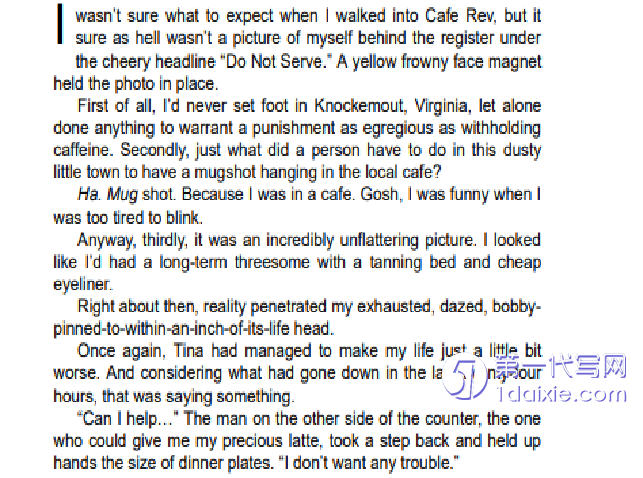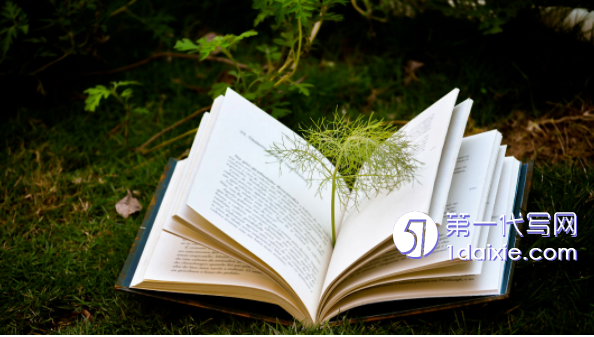本文是一篇英语论文,笔者认为在关联理论的指导下,翻译实践报告结合关联理论的明示推理过程,通过结合词汇、句子和语篇的分析对如何灵活使用翻译策略构建最佳关联进行探讨。
Chapter 1 Task Description
1.1 Selection of Things We Never Got Over
Through the study of several specialized courses, the translator systematically has learned the stylistic features and translation methods of various types of texts during her postgraduate studies, and she is deeply interested in literary translation, especially in the text type of novels. Therefore, the literary works are taken as the direction of this translation practice.
The translator has always admired the power of love since she was a child. Love in Eastern countries is conventional and conservative, while it is brave and passionate in Western countries. The love described by Lucy Score is like that, brave and passionate. As Lucy believes that love would appear after overcoming hardships and obstacles, she writes many series novels to describe this kind of romantic love, one of them is the Knockmout series: Things We Never Got Over, Things We Hide From Light, and Things We Left Behind. The stories that happen in Knockmout town are romantic, but the love represented in Things We Never Got Over is the kind of love that the translator do long for. And this novel has been well received by readers as soon as it was published.
After searching on the Internet, the translator confirms that there is no official Chinese translation of this novel at present. Therefore, after the extensive literary qualities’ comparison, the love novel Things We Never Got Over is chosen as the source text in this translation practice.

1.2 Analysis of the Source Text
The translation of any material, reading the full text and analyzing the source text before translation is the premise of a comprehensive understanding of the source language text.
1.2.1 Introduction to the source text
Things We Never Got Over, published in January, 2022, was written by Lucy Score and has been well received by readers as soon as it was published. Lucy Score writes on the title page of this novel: to the bravest hearts. At the beginning of writing the novel, Lucy does not know what the main idea of the novel is. Later, with the development of the story plot, Lucy gradually realizes that the purpose of the story is to remind people to cherish their loved ones and be brave when they meet the loved ones. Only by being brave can they get what they want.
The story’s heroine, Naomi, runs away from her wedding and goes to a remote town to save her evil twin sister, Tina. When Naomi arrives, she finds that time has not washed away Tina’s annoying habits, even leaving behind a little girl, which makes the people in the town hate her. After arriving at a local coffee shop in town, Naomi has a series of unpleasant events with Knox who is jealous of evil and his image as a Viking. After a series of events, the two brave hearts gradually become aware of each other’s love.
Chapter 2 Theoretical Framework
2.1 Theoretical Overview of Relevance Theory
Relevance theory is a theory involving various fields proposed by Sperber and Wilson in the 1980s. It doesn’t start with the translation domain. Wilson’s student Gutt (1989) published Cognition and Relevance, which discussed relevance theory and cognition together. In 1991, Gutt published Translation and Relevance: Cognition and Context, which first applied relevance theory to the translation field. At the time, the application of relevance theory in the translation field has caused a sensation among many scholars.
In relevance translation theory, Gutt (1991) believes that translation is a reasoning process involving brain mechanisms, and it is a verbal communication act. The process of communication is regarded as an ostensive-inferential process. The success of communication depends on two factors, one is the speaker’s expression and the other is the audience’s reasoning. In the process of reasoning, reasoning must be reasonable based on relevance theory. Gutt also argues that the translator’s translation text aims to convey to the target language readers what the original communicator wants to convey to the original audience. Therefore, translation is a special communicative act within the framework of relevance theory.
2.2 Application of Relevance Theory
The relevance theory has a strong applicability to novel translation. Relevance theory focuses on the whole process of translation, in which the translator can flexibly use various translation methods, aiming at finding the best balance between the author’s intention and the reader’s cognitive environment and building a bridge of communication, which is the optimal relevance according to relevance theory, so that the reader can get the maximum contextual effect with the minimum cognitive effort.
On the one hand, the language of the novel as a special artistic symbol, its purpose is not simply to convey information, but more importantly, fresh unique aesthetic emotions and experiences. Therefore, the language of a good novel is usually not straightforward, but hides a wealth of emotions behind the words, giving readers room for imagination. In order to achieve this kind of artistic effect, the translator usually uses various translation methods to modify the statements, or breaks the established language habits, and innovates in the choice of words and the construction of sentences. Meanwhile, as different languages have different linguistic structures and cultural imagery, cultural defaults may be caused when translating into another language.
Chapter 3 Translation Process ................................. 8
3.1 Pre-translation Preparations ......................... 8
3.2 While-translation Procedure ................................. 9
3.3 Post-translation Modification ................................ 10
Chapter 4 Case Analysis ................................. 12
4.1 At the Lexical Level ................................. 12
4.1.1 Translation based on context knowledge ................................... 12
4.1.2 Translation based on background knowledge ............................ 16
Chapter 5 Conclusion ................................ 32
5.1 Major Gains............................... 32
5.2 Limitations ..................................... 33
Chapter 4 Case Analysis
4.1 At the Lexical Level
Vocabulary is the basic unit that constitutes the sentence and even the whole discourse. Therefore, how to accurately translate vocabulary is the first and the most fundamental problem in novel translation. However, English and Chinese belong to different language systems and have different rules of expression, and with the development of their respective language systems, English and Chinese expressions have become very different. Different countries and nationalities have different social environments, customs, historical backgrounds and values, which brings certain difficulties to the translation work. These factors are also reflected in the language level, resulting in cultural vacancies or unequal meanings of words.
4.1.1 Translation based on context knowledge
Language context knowledge, also known as working memory, is the unit of relevant information in previous utterances, including the mastery of the language used and the understanding of the context of language communication (He, 1989). As for context in translation, Newmark (2001) points language context is a more important factor in all translation than any laws and basic senses. The influence of language context knowledge is an important factor that can’t be ignored in translation process. In the process of translation, the translator should read the whole text, have a general understanding of the story, and grasp the translation of individual words better, so as to make the language more smoothly.

Chapter 5 Conclusion
5.1 Major Gains
Through this translation practice, the translator recognizes the powerful guiding force of the relevance translation theory to the translation of literary works. The problem that the translator has been thinking about in the translation process was how to make the translated text reproduce the author’s linguistic style characteristics while accurately conveying her real intentions. In the specific translation process, the gains are as follows:
Accurate communication needs the proper meanings of words. Due to the differences between the Chinese and English languages, translating mechanically only according to the meaning of the words shown in the dictionary is likely to fail to accurately convey the author’s communicative intent, with problems such as hard and incomprehensible translations and serious translation accents. In the process of translating vocabulary, the translator should accurately grasp the basic meanings of vocabulary; they should not isolate the vocabulary outside the text, but should put the vocabulary into sentences and the whole discourse, and make a reasonable judgment on the meaning of the words according to the semantic clues and emotional clues provided by the original text.
Translation of sentences. Due to the characteristics of the differences between the English and Chinese languages, sentences are not simple expressions of the author’s intention, but contain implicit information that the author wants to express. In the process of translating complex sentences, the translator, with the help of consulting tools and relevant literature, flexibly splits and reorganizes them according to the meaning of the sentences and Chinese language habits, and tries her best to restore the linguistic style of the original text based on ensuring the accurate conveyance of semantics and conforming to Chinese language habits.
reference(omitted)
